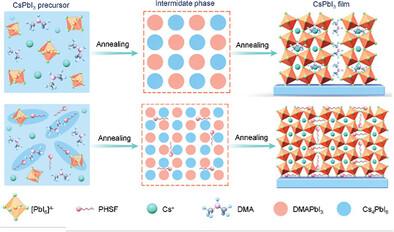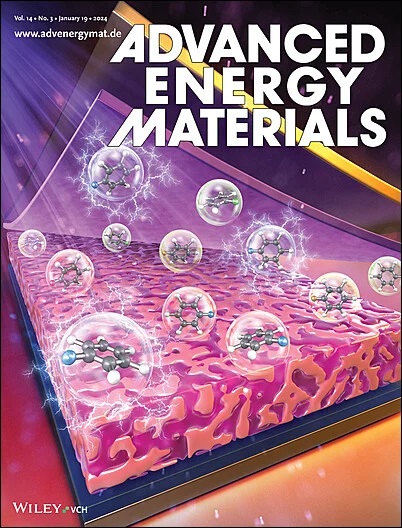操纵高性能全无机钙钛矿光伏电池的中间表面能
IF 24.4
1区 材料科学
Q1 CHEMISTRY, PHYSICAL
引用次数: 0
摘要
从DMAPbI3和Cs4PbI6中间体到最终的CsPbI3钙钛矿相的完整相变对于制备高质量的无机钙钛矿薄膜至关重要。在本研究中,DMAPbI3和Cs4PbI6之间的反应能垒试图通过增加它们的表面能来降低,其中使用DFT建模设计了一种全氟化合物来饱和中间体的表面,以有效地阻止它们的结晶生长。因此,具有超高表面能的小中间体反应更积极,有助于快速转化为所需的钙钛矿相。结果表明,无机钙钛矿的结晶度和形貌得到了改善,非辐射复合受到抑制,载流子寿命延长。结果,优化后的无机钙钛矿太阳能电池(PSCs)实现了超过20%的功率转换效率(PCE),同时显著提高了光和热稳定性。本研究为高质量无机钙钛矿的结晶动力学调控提供了一条途径。本文章由计算机程序翻译,如有差异,请以英文原文为准。

Manipulating Intermediate Surface Energy for High-Performance All-Inorganic Perovskite Photovoltaics
The complete phase transition from DMAPbI3 and Cs4PbI6 intermediates to the final CsPbI3 perovskite phase is pivotal for fabricating high-quality inorganic perovskite films. In this study, the reaction energy barrier between DMAPbI3 and Cs4PbI6 is sought to be reduced by increasing their surface energy, where a perfluorinated compound is designed using DFT modeling to saturate the surface of the intermediates to effectively prevent their crystalline growth. Consequently, the smaller intermediates with ultrahigh surface energy react more energetically to facilitate a rapid conversion to the desired perovskite phase. It is found that the resultant inorganic perovskite shows improved crystallinity and morphology, as demonstrated by suppressed non-radiative recombination and prolonged carrier lifetimes. As a result, the optimized inorganic perovskite solar cells (PSCs) achieve a power conversion efficiency (PCE) of over 20%, along with significantly improved light and thermal stability. This work provides a way to regulate crystallization dynamics for advanced quality of inorganic perovskites.
求助全文
通过发布文献求助,成功后即可免费获取论文全文。
去求助
来源期刊

Advanced Energy Materials
CHEMISTRY, PHYSICAL-ENERGY & FUELS
CiteScore
41.90
自引率
4.00%
发文量
889
审稿时长
1.4 months
期刊介绍:
Established in 2011, Advanced Energy Materials is an international, interdisciplinary, English-language journal that focuses on materials used in energy harvesting, conversion, and storage. It is regarded as a top-quality journal alongside Advanced Materials, Advanced Functional Materials, and Small.
With a 2022 Impact Factor of 27.8, Advanced Energy Materials is considered a prime source for the best energy-related research. The journal covers a wide range of topics in energy-related research, including organic and inorganic photovoltaics, batteries and supercapacitors, fuel cells, hydrogen generation and storage, thermoelectrics, water splitting and photocatalysis, solar fuels and thermosolar power, magnetocalorics, and piezoelectronics.
The readership of Advanced Energy Materials includes materials scientists, chemists, physicists, and engineers in both academia and industry. The journal is indexed in various databases and collections, such as Advanced Technologies & Aerospace Database, FIZ Karlsruhe, INSPEC (IET), Science Citation Index Expanded, Technology Collection, and Web of Science, among others.
 求助内容:
求助内容: 应助结果提醒方式:
应助结果提醒方式:


